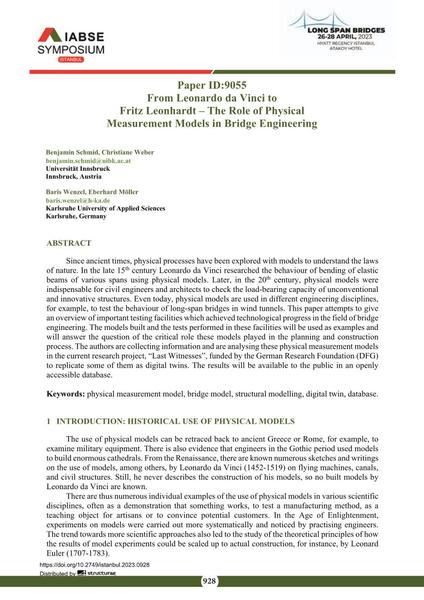From Leonardo da Vinci to Fritz Leonhardt – The Role of Physical Measurement Models in Bridge Engineering

|
|
|||||||||||
Détails bibliographiques
| Auteur(s): |
Benjamin Schmid
(Universität Innsbruck, Innsbruck, Austria)
Christiane Weber (Universität Innsbruck, Innsbruck, Austria) Baris Wenzel (Karlsruhe University of Applied Sciences, Karlsruhe, Germany) Eberhard Möller (Karlsruhe University of Applied Sciences, Karlsruhe, Germany) |
||||
|---|---|---|---|---|---|
| Médium: | papier de conférence | ||||
| Langue(s): | anglais | ||||
| Conférence: | IABSE Symposium: Long Span Bridges, Istanbul, Turkey, 26-28 April 2023 | ||||
| Publié dans: | IABSE Symposium Istanbul 2023 | ||||
|
|||||
| Page(s): | 928-935 | ||||
| Nombre total de pages (du PDF): | 8 | ||||
| Année: | 2023 | ||||
| DOI: | 10.2749/istanbul.2023.0928 | ||||
| Abstrait: |
Since ancient times, physical processes have been explored with models to understand the laws of nature. In the late 15th century Leonardo da Vinci researched the behaviour of bending of elastic beams of various spans using physical models. Later, in the 20th century, physical models were indispensable for civil engineers and architects to check the load-bearing capacity of unconventional and innovative structures. Even today, physical models are used in different engineering disciplines, for example, to test the behaviour of long-span bridges in wind tunnels. This paper attempts to give an overview of important testing facilities which achieved technological progress in the field of bridge engineering. The models built and the tests performed in these facilities will be used as examples and will answer the question of the critical role these models played in the planning and construction process. The authors are collecting information and are analysing these physical measurement models in the current research project, “Last Witnesses”, funded by the German Research Foundation (DFG) to replicate some of them as digital twins. The results will be available to the public in an openly accessible database. |
||||
